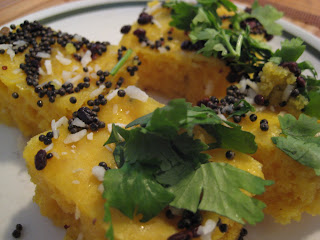
...With profound apologies to all the vegans out there.
Hollandaise sauce has always been one of those recipes that I've been dying to make. Having grown up eating mostly Indian food, I've always had a fascination with continental foods. At Christmas time, we always made Eggs Benedict, and after trying to make a hollandaise at home, I now realize that the endeavor is a labour of love.
Hollandaise is a emulsification of the yolk of eggs, butter, and vinegar, with pepper and lemon sometimes adding spice and tang. It is a French sauce, and was made as early as 1651 by Francois Pierre La Varenne in his groundbreaking book Le Cuisinier Francois. However, the sauce mimics a Dutch sauce, hence the "holland" in hollandaise. It is considered one of the 5 mother sauces in French cooking.
Last Saturday, I made hollandaise sauce with artichokes, and stuffed pasta shells for an early holiday dinner for The Mixmaster. I altered an Epi recipe, and came up with what you see below. A few notes: Feel free to add a squirt or two of extra lemon for tartness; I found with the vinegar that my recipe was tart enough. Also, I used black pepper. All the recipes I found beg you to use white. But what's wrong with a little colour? I liked the flecks throughout the sauce. And finally, when rewarming the sauce, be sure to do so on low heat. Separated hollandaise can really be a downer at one's otherwise festive holiday brunch...
Recipe (for 1 1/2 cups):
2 tablespoons pure white vinegar
3 tablespoons cold water
1/4 teaspoons salt
black pepper to taste
3 large egg yolks (preferably free run)
2 sticks butter (1 cup), unsalted, cut into 1 tablespoons pieces and softened
2 tablespoons fresh lemon juice (optional, if you like it very tart)
- Boil vinegar, 2 T water, salt, and black pepper in medium saucepan with a heavy bottom, until reduced to about 2 tablespoons (this happens quickly).
- Remove from heat and add additional tablespoon of water.
- Whisk in yolks and cook over very low heat, whisking constantly, until thickened (be careful not to scramble yolks). I had the heat at about 2-3 on my stove.
- Whisk in butter one piece at a time, you may lift pan occasionally to cool sauce.
- If adding lemon juice, do so after the pan is removed from heat. Also add salt, to taste.
I hope you all have a lovely holidays!
viga














